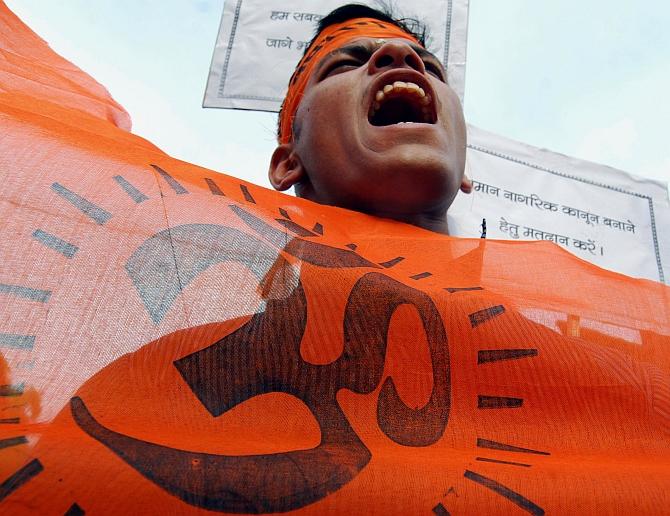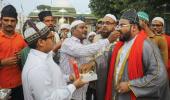'The idea of a 'Hindu Rashtra' only emerged in the 1920s and 1930s.'
'The context at that time was the clear British attempt at 'divide and rule' between Hindus and Muslims and within Hindus on caste lines,' argues military historian Colonel Anil A Athale (retd).

The recent controversy and agitation over the badly drafted Citizenship (Amendment) Act has revived the bogey of India turning into a 'Hindu Rashtra'.
But the CAA is merely an excuse. This attempt is similar to the on-off debate over Veer Savarkar and his 'feigned apology' (as commented by the British) to survive the Andaman prison and secure his release.
The historical context of these events, actions and ideologies is deliberately being obfuscated to suit current political needs.
It is conveniently forgotten and never mentioned that around the time Veer Savarkar was being accused of being apologetic to the British, Mahatma Gandhi and many other leaders of the freedom struggle were actively helping the British war effort.
Gandhiji was conferred the Kaiser E Hind award for his services to the British crown which he returned in 1920 post the Jallianwala Bagh massacre.
In the historical context of the time, Gandhi and many others felt that this was the best method to get dominion status or 'self rule' 'home rule' for India.
The current crop of politicians with selective memory never bring this out, and also forget that during World War I, the Germans had tasked their cruiser Emden (that had bombarded Madras port) to attempt a rescue of Savarkar from Andaman prison.
Savarkar's contacts with Irish revolutionaries is also a matter of record.
Yet, despite all this, a campaign to malign him continues unabated.
Recently former prime minister Dr Manmohan Singh had accepted Savarkar's contribution, but asserted that he was opposed to the concept of a 'Hindu rashtra' propagated by him.
To understand the entire bogey of a Hindu rashtra, on the lines of an Islamic State, it is necessary to know the historical context of the idea.
Like Gandhiji's actions during WWI, it must also be seen in its historical background.
In its close to 5,000-year history, India has never had the concept of a faith-based nation. The king was expected to follow 'Raj Dharma'.
Dharma is more akin to a value system that is indicative of duties rather than faith. Thus, there is 'Dharma' of various kinds, like Pitru Dharma (fatherly duties), Putra Dharma (son's duties), Manav Dharma (humanism) or Rashtra Dharma (duties towards the country) that one is expected to follow.
The only exception to this rule of faith neutral rule was during Ashoka's time when he made Buddhism the State religion and actively promoted and propagated the Buddhist faith and teaching it both within India and abroad.
The only other attempt of spreading faith with State power was during Aurangzeb's time. This attempt too failed as it led to a revolt by Sikhs and Jats in the north and a determined organised resistance by the Marathas on the Narmada so the south of India also remained out of Mughal grasp.
In the East, the Mughal onslaught was checked by the Ahoms of Assam under Lachit Borphukan.
This is in direct contrast to Abrahamic faiths wherein both Christianity (till the Reformation and Renaissance) and Islam had faith-based rule.
The concept of a caliphate and its duty to spread the faith has been a feature of Islam right till the 21st century.
The rise of ISIS and the widespread support it gathered all over the Islamic world shows the power of this idea.
In the modern era, while the caliphate ceased to exist, various Muslim majority States have declared themselves as 'Islamic States' where Islam is the official faith.
The Indian subcontinent has followed a different trajectory. The underpinning of Indian civilisation and culture was Vedic and Upanishadic philosophy.
This put forward the concepts like Vasudhaiv kutumbakam (the whole world is one family) or ekam sat vipra bahudha vadanti (truth is one but called by different names) from the Upanishads.
The outcome of this was the mind-boggling diversity of faiths, languages, races and culture found in the subcontinent.
In the conventional understanding of 'religion', ancient pre-Christian era India had three broad streams: The Vaishnavas or worshippers of Vishnu, the Shaivaites or worshippers of Shiva, and Shakta or worshippers of Mother Goddess or Shakti.
In the later period, Jainism, Buddhism and Sikhism emerged as reform movements and revolts against Vedic orthodoxy and became separate religions in the Western sense of the term. These multiple faiths co-existed peacefully.
The initial arrival of Christianity in South India through St Thomas, or Islam in the seventh century in Kerala and western coast through Arab traders, is well known. Al Baruni, who came to India in the 11th century during the invasions by Muhammad Ghazni, has noted the presence of Muslim settlements on the western coast.
It was around this time the word 'Hindu' was first coined and basically referred to the land of the Sindhu river valley and beyond. Sindhu became Hindu and the Arabs began to refer to the land as Hindustan -- or land of the Hindus.
The Southern part of the subcontinent continued to be called Deccan or Dakkhan or simply the south right up to modern age. The people living south of Narmada were simply referred to as Dakkhanis or southerners, separate from Hindus.
Thus narrowly defined, the Hindu Rashtra roughly corresponds to current Pakistan.
Given this historical background and understanding of the Indian past, the idea of a 'Hindu Rashtra' only emerged in the 1920s and 1930s. The context at that time was the clear British attempt at 'divide and rule' between Hindus and Muslims and within Hindus on caste lines.
The British encouraged Muslim separatism and militancy and recruited Muslims in larger numbers in the armed forces. This was a complete reversal of policies followed by them immediately after the 1857 revolt.
The foundations of a separate 'Muslim' State were laid when a delegation of 35 Muslim leaders met then British viceroy Lord Minto on August 10, 1906, and demanded and got separate electorates and larger share in power.
With inputs from Lieutenant Gen Ashok Joshi (retd).
- Part 2: It's Bharatiyata, not Hindutva!










